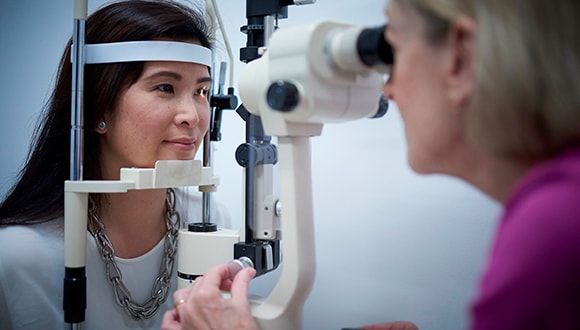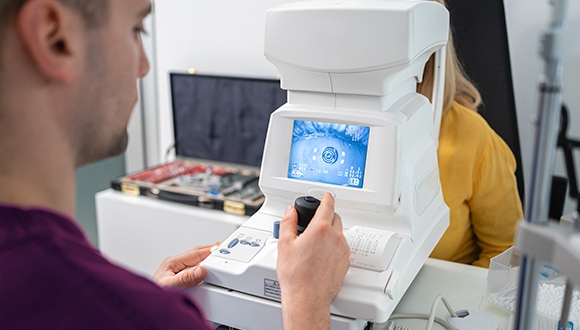Eye tests and check-ups for healthy eyesight
Updated September 2023 | 4 min read
Expert contributor Yu-Yun Wang, Managing Optometrist at HCF Eyecare
To protect your eyesight and maintain good eye health, it’s important to have regular eyesight tests with a qualified optometrist. But how long does an eye test take and what types of things do they look for? Here’s what you need to know when getting your eyes checked.
Our eyes are a vital part of our lives. "From being able to read and to drive, to using the computer and enjoying the world around you, everyone from young to old needs to have their eyes checked,” says Yu-Yun Wang, Managing Optometrist at HCF Eyecare. "Our eyes can reveal a lot about our general health."
So, what exactly happens when you visit an optometrist and how do eye tests work? Here’s a guide to understanding the eye testing process, what optometrists look for and the eye checks performed.
Booking an eye test
When you ring to book in for an eye check, make sure you mention family history of eye conditions like glaucoma, for example, or health conditions like diabetes that may indicate you need a longer appointment.
"If you have diabetes, we need to do an extra dilated eye examination to have a more comprehensive look at the back of the eyes for any signs of diabetes. General health and family history can also mean that we need to look at the eyes a little closer in order to provide the best possible care,” says Yu-Yun.
If you’re interested in being free of glasses and trying contacts for the first time, mention this to the optometrist, too.

How often should I book an eye test?
It's essential to keep on top of our eye health and book an eye check for good optical health. Depending on your level of cover, eligible HCF members can also get 100% back on a pair of prescription glasses or sunglasses from a selected range when you visit any of our Eyecare Centres or selected providers in our No-Gap network*.
Yu-Yun says for most people who are young and quite healthy, one check-up every two to three years is enough. But he urges people to get checked as soon as they notice any changes to their eye health. "As people get older, they become more susceptible to various eye conditions like cataracts, glaucoma and macular degeneration and so we recommend an annual check-up,” he says.
When should I get my child's eyes checked?
A lot of children will go through a screening program to check their eyes before they start school. For example, in New South Wales, the StEPS program offers all four-year-old children free vision screening. These tests can uncover any issues with ocular health, but you can also take your child to an optometrist for a general check when they're four or five years old.
Yu-Yun says he sees some children who are younger, but it can be limited by how well the child can respond to the tests. "For children under six, we're trying to screen for any major eye conditions, like a lazy eye, or if they're very short-sighted or long-sighted. We're also making sure that the eyes are functioning well, and that they are reaching the visual developmental milestones," he says.
Pre-test consultation
If you’ve booked into one of HCF’s Eyecare Centres, you'll get a pre-examination questionnaire, which gives you an opportunity to provide information, like the list of medications you’re using and the details of your GP.
On the day of your consultation, the optometrist asks additional questions to clarify the main reasons for your visit – if you’re experiencing headaches or blurred vision, or simply want an eye check-up.
HCF opened our first Eyecare Centre in Sydney’s HCF House, in 1992, right alongside the already well-established Dental Centre. Just like the motivation behind the Dental Centres, the Eyecare Centres were opened to provide our members with high-quality clinical eyecare. And we’ve continued to provide that care ever since. Learn more about our Eyecare Centres and how we were one of the first in the country to build a team of clinicians who were trained in their field of expertise.
Eye checks during examination
When you go in for your eye check-up, your optometrist will conduct some or all of the following eye tests.
Visual acuity test
With one eye covered, you read letters of the alphabet from a chart, with the type getting smaller with each row. This measures your sharpness of vision. "It's to get a baseline and see where the visual function is. It gives us a very important measurement, telling us the clarity of their vision,” says Yu-Yun.
Refraction test
If you need or use glasses your optometrist will ask you to look through a series of different lenses and pick which one looks clearer to determine the most appropriate lens power.
The prescription is handed to an optical dispenser who helps you choose your glasses frames and arranges for them to be made up with the prescribed lenses. This may take a few days or weeks.
Eye function tests
The optometrist tests your muscle function, eye coordination and peripheral vision by getting you to visually track a moving object, look at a distant target and bringing objects or computer images into your line of vision. Colour vision and depth perception can also be tested by using special books and glasses.
Slit lamp check
A special microscope with a strong light illuminates the structures of your eye to allow assessment of your eyelids, lashes, irises, corneas and lenses. Here, an optometrist can pick up eye conditions like ocular dryness and cataract.
Glaucoma screening
Glaucoma is a condition which accelerates the natural deterioration of the optic nerve, causing side vision loss.
"Glaucoma is often called the 'silent thief of sight' because you don't notice that you have it until it's in the mid or the late stage. This is because your eyes and brain are very good at hiding if you've lost any peripheral vision as your brain is very good at filling in the gaps," says Yu-Yun.
Side vision is vital for essential day-to-day tasks like driving and navigation. Tests for the condition include an optic nerve examination and a visual field test. The optometrist uses a visual field test to analyse the extent of your side vision. All HCF Eyecare Centres have invested in new visual field machines, the Zeiss Humphrey Field Analyzer 3, which has long been the industry gold standard for visual field testing.
A tonometer measures the eye pressure by directing a small puff of air to the eye. “High eye pressure measurement may indicate a higher risk of glaucoma,” Yu-Yun says.
Dilation test
The pupil controls the light travelling into your eye. When we shine light into the eye, it naturally constricts and becomes smaller.
This can make it more difficult for the optometrist to assess the structures inside the eye, like the macula and blood vessels, so they may use pupil dilating drops and a head-mounted instrument known as a binocular indirect ophthalmoscope. It's also necessary to look at the structures further away from the centre of the back of the eye.
“As your vision may be affected for an hour or two after the test, we recommend not to drive for two hours and to wear sunglasses to prevent glare,” Yu-Yun says.

Retinal and OCT imaging
A fundus camera allows the optometrist to take a photograph of the inside of the eye, or the retina. Here, the optometrist can show you the back of your eye and discuss what features they’re looking out for, as well as conditions like macular degeneration.
A high-tech scan, called an optical coherence topographer, goes into further detail and looks at separate layers in the retina. This technology allows the optometrist to compare your eyes with age-related norms and track the progression of the retinal tissue over time. These tools offer excellent insight and allow the optometrist to intervene at earlier stages as soon as any signs of macular degeneration, glaucoma or the impacts of stress and high blood pressure are detected.
This service is offered for free at HCF Eyecare Centres for members and is funded by HCF, as we know how important it is to put our money where our members are.
Yu-Yun says, "A lot of the patients are very, very satisfied and also excited to see that we do have all the latest in terms of the technology to look after our members. And they're able to make the most of their extras cover as well. I'm thankful that HCF has invested into this technology so we can offer the services and the care that we want our members to have."
What happens after your eye test
With all the information gathered from the eye tests, the optometrist will make recommendations on solutions to suit your lifestyle. This can include contact lenses, prescription sunglasses, swimming goggles, cycling glasses, refractive surgery, as well as special lenses and lens coatings which are tailored to the level of your screen time.
The optometrist also will advise you of when to have your next eye check-up and, if necessary, make recommendations on eye exercises, eyedrops, diet, lighting needs or the need to see an eye specialist.
Book an eye test
If you're Sydney-based, our network of HCF Eyecare Centres gives members easy access to high-quality, affordable healthcare. Don’t live near one? You could still get 100% back* on popular optical services through our extensive No-Gap network.
Related articles
CAN YOU PREVENT SHORT-SIGHTEDNESS?
Short-sightedness is on the rise. Here are ways to manage and even prevent it in both children and adults.
EYE HEALTH ALERTS
Eyes can give doctors valuable insights into a range of potentially dangerous health conditions.
MACULAR DEGENERATION: WHAT YOU NEED TO KNOW
Find out if you’re at risk of being affected by this eye disease and how you can lower your risk factors.
HEALTH CHECKS BY AGE: THE TESTS YOU SHOULD BE HAVING
Your guide to staying on top of your health, through every stage of life.
IMPORTANT INFORMATION
* Waiting periods and annual limits apply. 100% back available on selected covers for prescription glasses and sunglasses, and contacts. Excludes add-ons like high index material, coatings and tinting.
This communication contains information which is copyright to The Hospitals Contribution Fund of Australia Limited (HCF). It should not be copied, disclosed or distributed without the authority of HCF. Except as required by law, HCF does not represent, warrant and/or guarantee that this communication is free from errors, virus, interception or interference. All reasonable efforts have been taken to ensure the accuracy of material contained on this website. It’s not intended that this website be comprehensive or render advice. HCF members should rely on authoritative advice they seek from qualified practitioners in the health and medical fields as the information provided on this website is general information only and may not be suitable to individual circumstances or health needs. Please check with your health professional before making any dietary, medical or other health decisions as a result of reading this website.